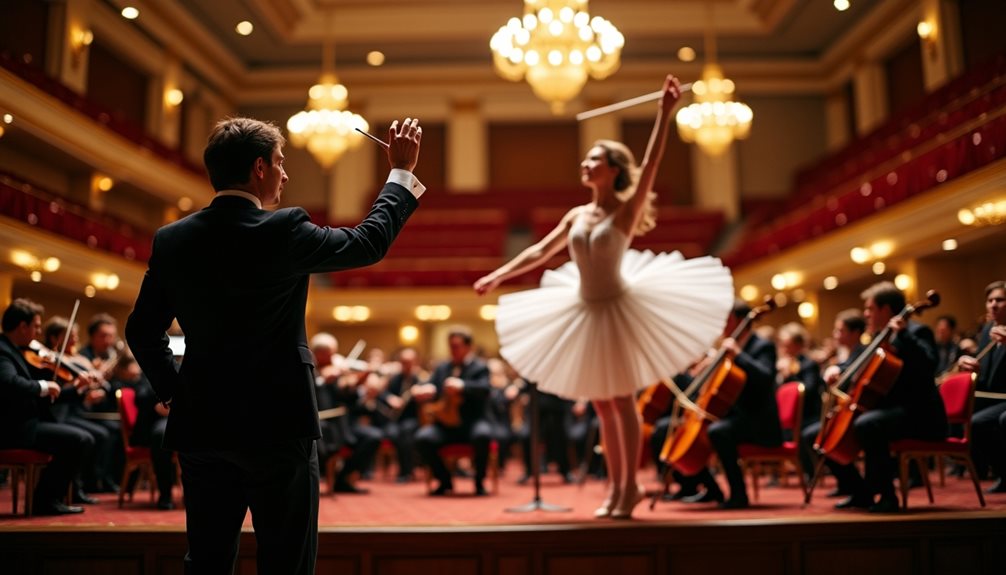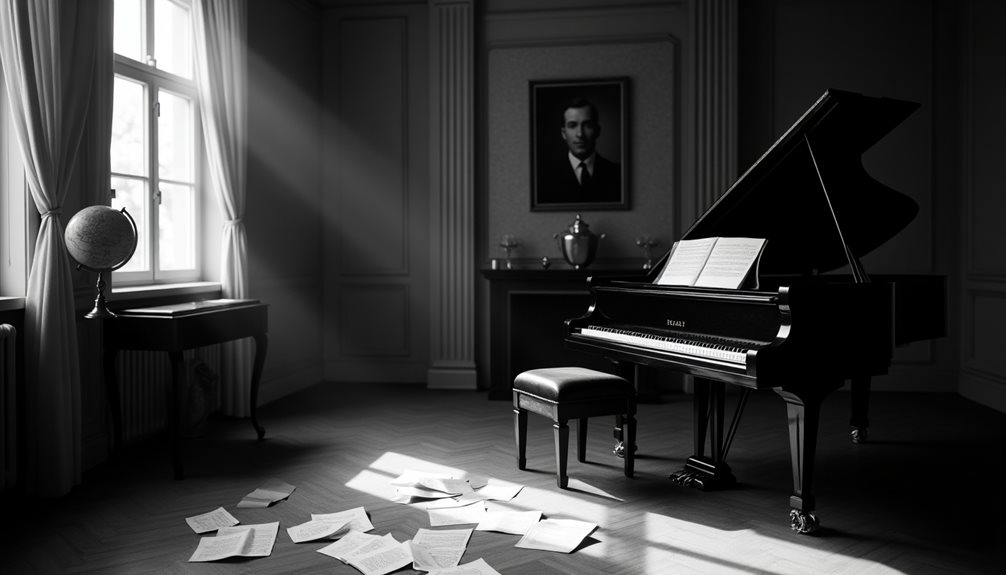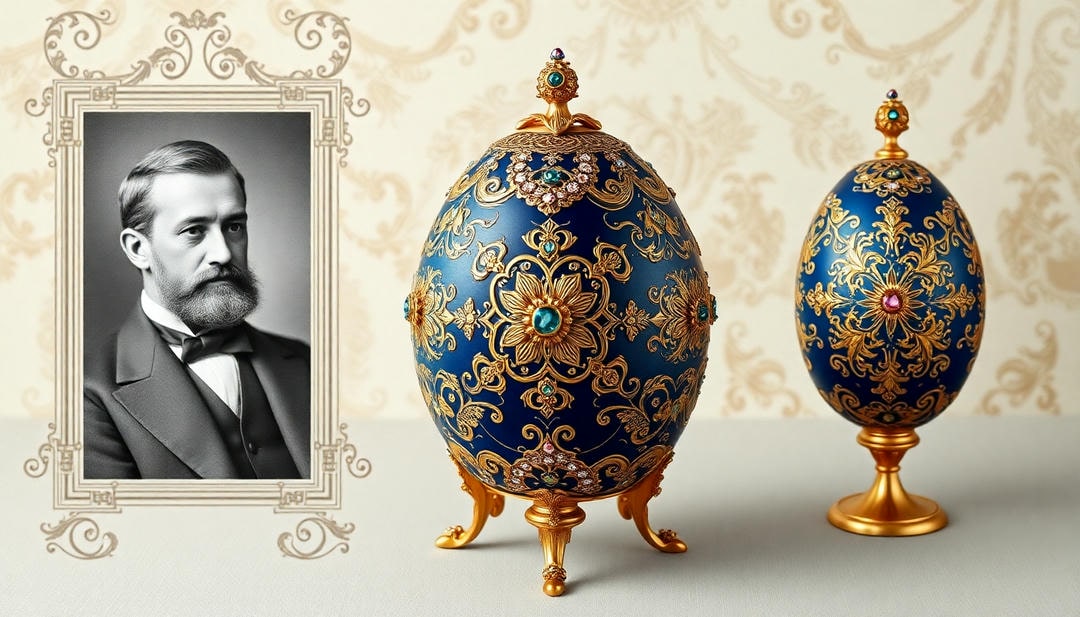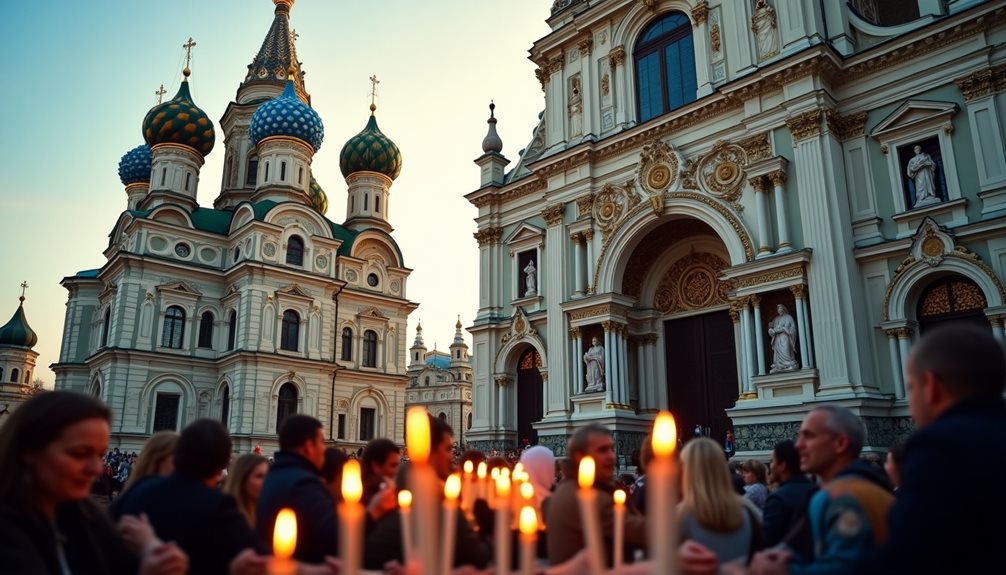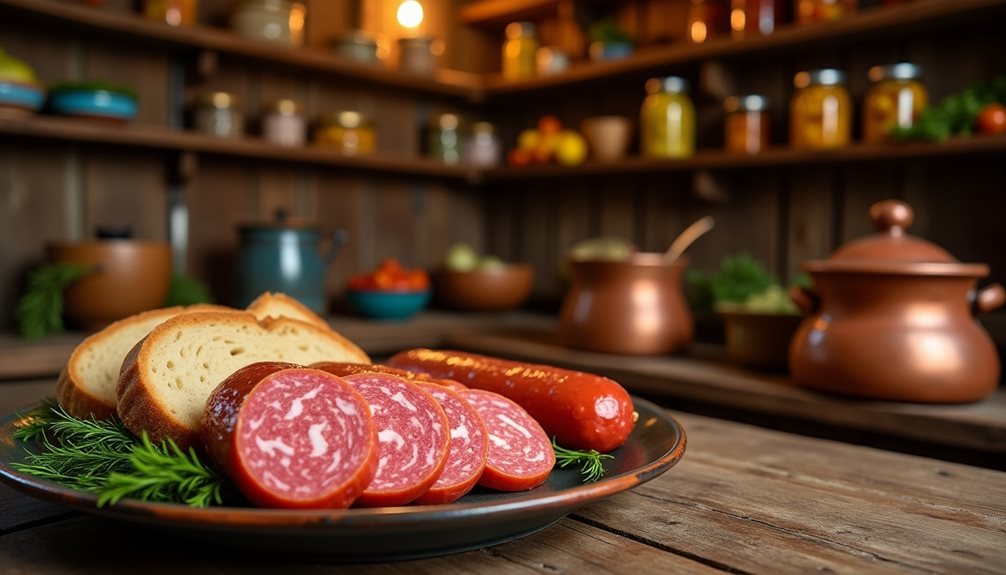Russian classical music’s story is a complex one, deeply rooted in the nation’s cultural and historical journey. Emerging from a vibrant exchange of ideas, it blends Western classical approaches with native folk traditions. This fusion reflects Russia’s desire to forge a unique and authentic musical identity.
Music education reforms played a crucial role in this development, incorporating folk elements into formal training and solidifying a distinct national style. This integration sparked a dynamic conversation between traditional and contemporary forms, leading to groundbreaking compositions that resonated worldwide.
Development of Russian Classical Music
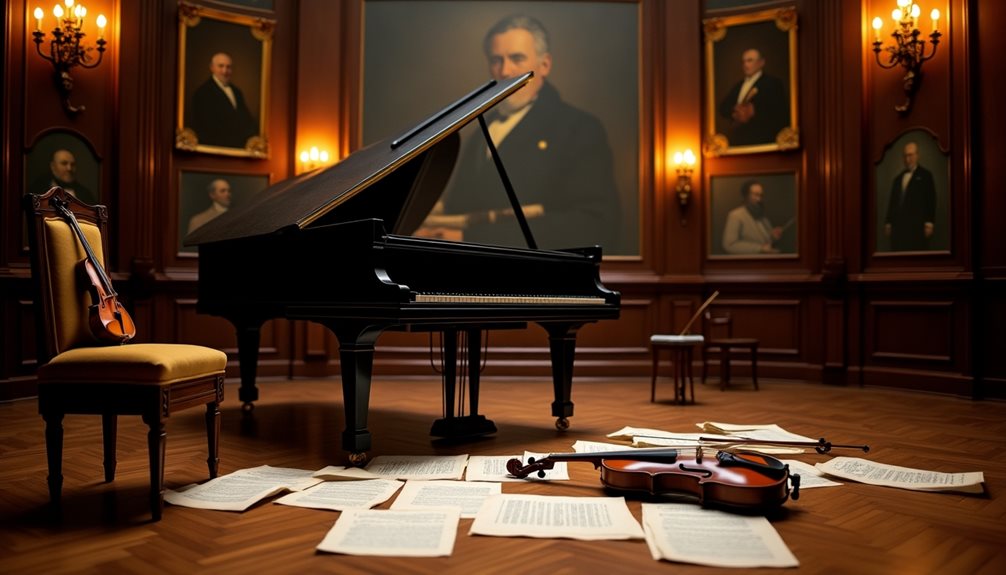
The origins of Russian classical music lie in the convergence of diverse cultural influences, particularly ecclesiastical and folk traditions. Sacred music, exemplified by Byzantine chants, provided a spiritual foundation, while folk music added vibrancy and regional character. Early instruments like the gusli and sopilka embodied this duality, offering unique tonal palettes. Surviving musical manuscripts reveal the intricate relationship between sacred and secular elements. Cultural exchange, facilitated by trade and migration, further enriched this evolving musical landscape, setting the stage for a unique Russian classical identity.
The Muscovy Period
During the Muscovy Period (1283–1547), a clear distinction emerged between sacred Orthodox Church music and secular compositions for entertainment. This era was a significant phase in Russia’s cultural evolution, marking a period of increasing musical differentiation. Sacred music, liturgical in nature, served the spiritual and ceremonial needs of the Orthodox Church, emphasizing vocal harmonies and religious texts. Secular music, in contrast, thrived as a vibrant form of entertainment, often performed at social gatherings and royal courts. This separation not only reflected societal values but also fostered a diverse musical environment, paving the way for future innovations.
Byzantine Influence
Russian sacred music undeniably owes its origins to the profound influence of the Byzantine Empire, a civilization celebrated for its sophisticated musical heritage. This influence is evident in the adoption of sacred choral practices within Russian Orthodox traditions. Choral singing, a prominent feature of Byzantine liturgies, became integral to Russian religious ceremonies, enriching the musical heritage with complex harmonies and vocal arrangements. Additionally, the unique Russian Orthodox bell ringing, with its intricate patterns and spiritual resonance, reflects Byzantine liturgical sounds. This fusion of Byzantine elements enriched Russian sacred music, laying a foundational framework that shaped its distinctive spiritual sound.
Early Music Theory of the 18th Century
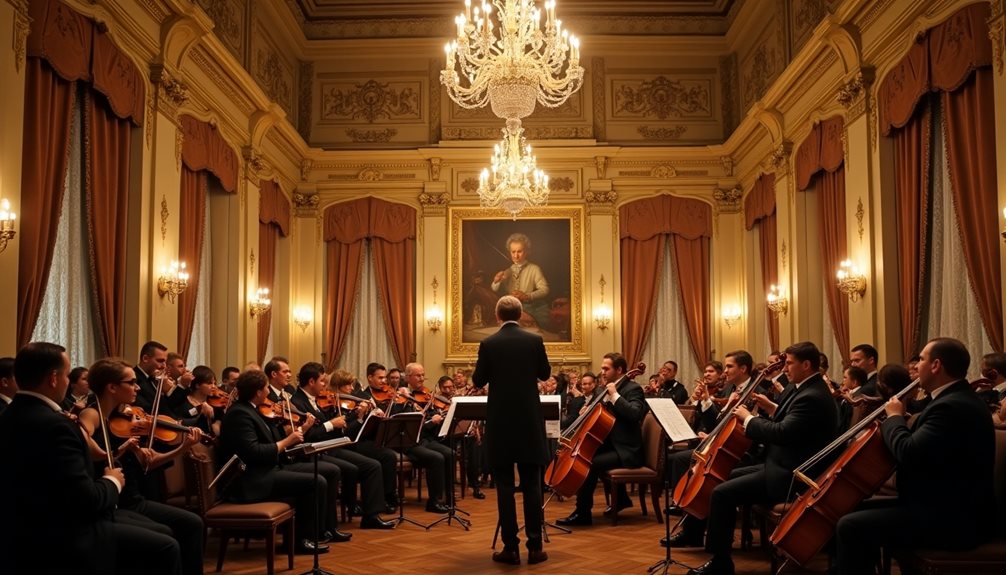 Nikolay Diletsky, a prominent Ukrainian composer and music theorist, made significant contributions to the development of early music theory in Russia with his groundbreaking work, “A Grammar of Musical Singing.” This treatise, considered the first of its kind in Russia, offered a systematic approach to music composition and vocal performance, laying the groundwork for future theoretical advancements. By emphasizing structured music education, Diletsky facilitated cultural exchange between Eastern and Western traditions, thereby enriching Russian choral traditions. His work addressed vocal techniques within historical contexts, fostering a deeper understanding of harmony and polyphony. Consequently, Diletsky’s treatise became a cornerstone for Russian musical innovation.
Nikolay Diletsky, a prominent Ukrainian composer and music theorist, made significant contributions to the development of early music theory in Russia with his groundbreaking work, “A Grammar of Musical Singing.” This treatise, considered the first of its kind in Russia, offered a systematic approach to music composition and vocal performance, laying the groundwork for future theoretical advancements. By emphasizing structured music education, Diletsky facilitated cultural exchange between Eastern and Western traditions, thereby enriching Russian choral traditions. His work addressed vocal techniques within historical contexts, fostering a deeper understanding of harmony and polyphony. Consequently, Diletsky’s treatise became a cornerstone for Russian musical innovation.
Nikolay Diletsky’s foundational work paved the way for remarkable advancements in Russian music throughout the 18th century.
Facilitated by increasing cultural exchange with Western Europe, Russian composers began incorporating Baroque techniques into their work. This period saw Russian musicians adapt and adopt the intricate counterpoint and ornamentation characteristic of Baroque traditions. Western instruments like the violin and harpsichord also gained popularity, contributing to new sounds and styles.
The Rise of Russian Opera
Opera underwent a significant transformation as Russian composers began integrating Western narrative structures and theatrical elements. This blend of indigenous and Western musical practices added new depth to Russia’s cultural landscape.
Peter the Great’s reforms were instrumental in introducing Western music to Russia during the 18th century, fundamentally reshaping the nation’s cultural identity. His strategic initiatives fostered the adoption of Western instruments and encouraged cultural exchange. Royal patronage became essential, supporting musical education and fostering local talent. The establishment of opera houses signaled the burgeoning development of opera, with Western compositions captivating Russian audiences. Peter’s reforms laid the groundwork for blending Western musical aesthetics with Russian traditions, setting the stage for a dynamic cultural evolution.
Italian Influence at the Imperial Court
While Peter the Great initiated the introduction of Western music, the reigns of Empresses Elisabeth and Catherine saw Italian influence truly take hold. Imperial patronage drew Italian musicians to the Russian court, and Italian opera became a cornerstone of Russian culture. This era fostered artistic collaboration and a significant exchange of ideas. The Empresses’ support not only popularized Italian classical music but also established a lasting musical legacy, catalyzing transformative changes in Russia’s artistic environment and paving the way for future innovations.
As Italian influences permeated the Russian court, Russian composers began embracing Western musical styles, seeking artistic recognition and aiming to elevate their cultural standing. This cultural exchange sparked a fusion of Western forms with Russian folk elements, resulting in a distinct musical identity. The influence from Italian composers provided a familiar structure within which Russian musicians could innovate, integrating native motifs while aligning with European standards. This fusion enriched their compositions, retaining a unique Russian spirit.
Training in Italy
19th Century: Russian Music Ascends
Building on earlier Italian influences, the 19th century witnessed the rise of a uniquely Russian voice in classical music. Composers of this era actively sought to distinguish themselves from Western traditions, drawing inspiration from Russian folk music and exploring themes of national identity. This pursuit of cultural authenticity led to a vibrant evolution of classical music in Russia.
The integration of folk melodies and textures proved particularly impactful, enriching compositions and laying the groundwork for a distinct Russian musical identity. Mikhail Glinka emerged as a pivotal figure, widely regarded as the founder of Russian classical music.
His operas, notably Ivan Susanin and Ruslan and Lyudmila, were groundbreaking for their incorporation of Russian folk elements into the classical form. This innovative blend of indigenous tunes and Western operatic techniques had a profound impact on Russia’s cultural heritage. Glinka’s work tapped into a growing sense of national identity, reflecting Russian history and cultural values. His pioneering approach paved the way for future generations of composers to cultivate a truly Russian sound.
The Mighty Five
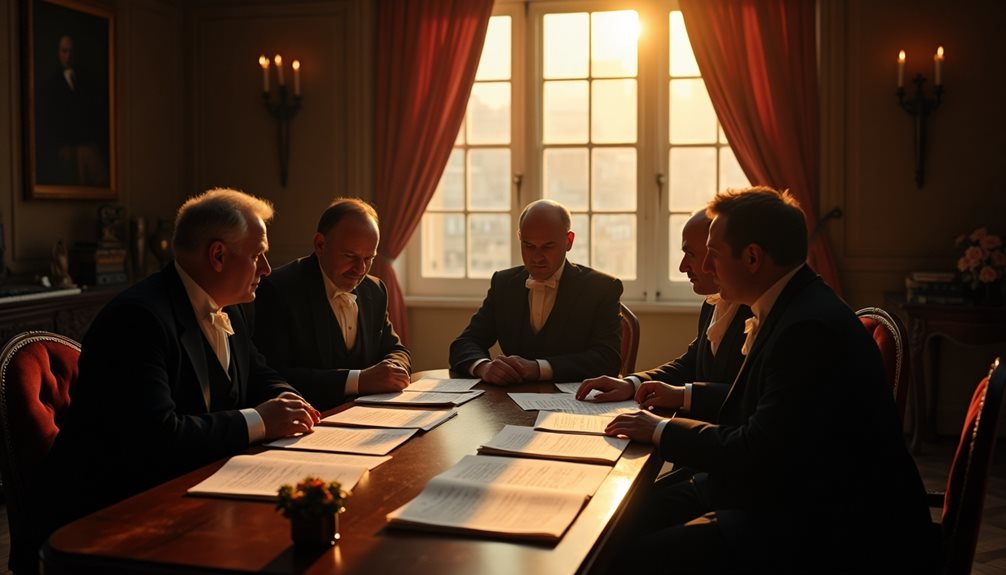
In the latter half of the 19th century, “The Mighty Five,” also known as “The Mighty Handful,” played a crucial role in solidifying a distinct Russian style of classical music. This group—Mily Balakirev, Nikolai Rimsky-Korsakov, Modest Mussorgsky, Alexander Borodin, and César Cui—championed innovation by weaving Russian folk traditions into their compositions.
Driven by a desire to express national identity, they worked to differentiate Russian opera from Western influences, making significant contributions to Russia’s musical heritage. Their commitment to authenticity and cultural representation served as a bedrock for future composers to build upon and expand Russian musical traditions.
The Russian Musical Society
Established in 1859 through the efforts of Anton and Nikolay Rubinstein, the Russian Musical Society (RMS) became a central institution in shaping Russia’s musical landscape. The RMS was instrumental in developing Russian musical education, establishing standards that nurtured the nation’s orchestras. By organizing classical music festivals, it provided vital platforms for contemporary composers to showcase their works, fostering a thriving musical environment.
The RMS also influenced music publishing, facilitating the wider distribution of Russian compositions. Through these efforts, the RMS played a key part in the development and international recognition of Russian classical music.
Peter I. Tchaikovsky (1840-93)
Following the establishment of the Russian Musical Society, the stage was set for the appearance of major figures in Russia’s musical canon, with Peter Ilyich Tchaikovsky standing as a towering figure.
Tchaikovsky’s diverse influences, ranging from Russian folk music to Western European traditions, contributed to his unique compositional voice. His operas, including Eugene Onegin and The Queen of Spades, demonstrate his masterful storytelling and emotional depth.
Despite personal challenges, including struggles with depression, Tchaikovsky created a musical legacy that extended far beyond Russia. His ballets, symphonies, and overall cultural impact continue to resonate, solidifying his position as one of Russia’s most important composers.
Sergei Rachmaninoff (1873–1943)
Sergei Rachmaninoff, a prominent figure in Russian classical music, embodied the late Romantic era through his expressive melodies and virtuosic piano compositions.
His compositions are celebrated for their emotional depth and detailed orchestral arrangements, demonstrating his skill in expanding the piano’s capabilities. Rachmaninoff’s piano concertos, especially the second and third, are considered major achievements, combining technical skill with profound emotional expression.
Rachmaninoff’s musical legacy continues to inspire many composers and performers, influencing their approach to balancing innovation with emotional intensity. His contributions affirmed his position as a successor to the Russian tradition of Peter Ilich Tchaikovsky.
A Century of Musical Transformation
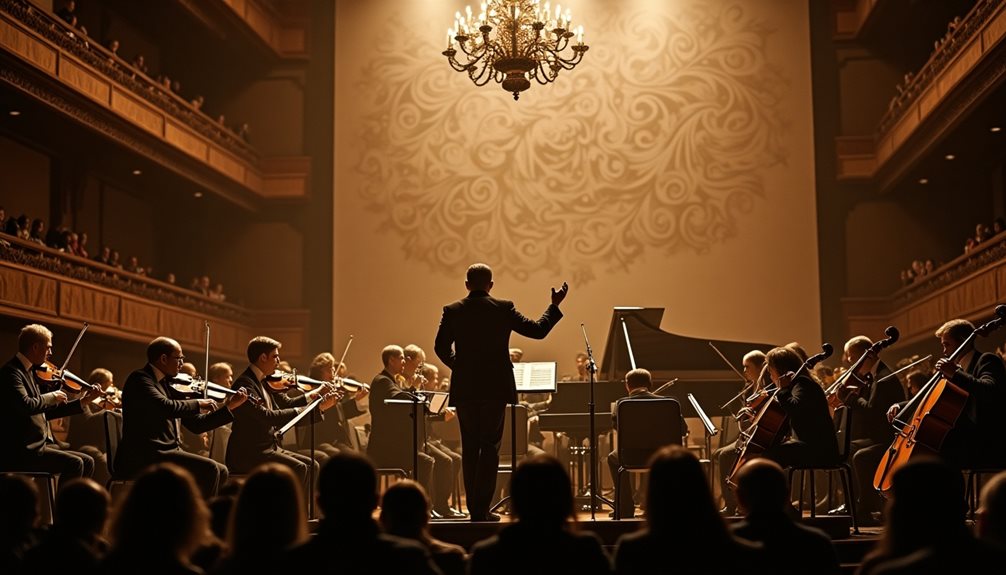
In the late 19th and early 20th centuries, Russian classical music experienced a transformation marked by experimentation and innovation. This period, sometimes called the third wave of Russian classical music, saw the rise of a musical avant-garde that adopted experimental composition techniques, integrating modern influences reflecting cultural exchanges between Russia and Western Europe. Composers explored new timbres and structures through innovative orchestration, setting the stage for a redefined musical identity and paving the way for future artistic movements.
Igor Stravinsky, Alexander Scriabin, Sergei Prokofiev, and Dmitri Shostakovich brought experimental styles and musical language to Russian classical music. These composers significantly reshaped the musical landscape:
- Igor Stravinsky innovated rhythmic complexity and orchestration, moving Russian music towards the avant-garde.
- Alexander Scriabin integrated mysticism, blending music with philosophical concepts.
- Sergei Prokofiev combined traditional and modernist elements.
- Dmitri Shostakovich conveyed emotional depth amidst political challenges.
Together, these composers transformed Russian classical music by challenging conventions and expanding its expressive possibilities
Emigration and Soviet Music
Following the Third Wave, the Russian classical music scene faced upheaval due to the Russian Revolution. The emigration of numerous composers altered the cultural identity of Russian music. Sergei Prokofiev’s return to the Soviet Union was a pivotal moment, as he integrated Western techniques with Soviet ideologies, influencing composer experiences within the regime and exemplifying the complex relationship between personal expression and state mandates.
Russian music is closely linked to its national identity, mirroring Russia’s historical and cultural evolution. Russian music incorporates folk traditions, contributing to a unique sound that reflects the nation’s ethnic diversity. Influenced by Byzantine chants and European classical forms, Russian composers crafted compositions that resonate with the national spirit, blending indigenous melodies and external influences to create an innovative musical identity.
Throughout Russia’s musical history, folk traditions and classical compositions have been interwoven. Composers drew inspiration from regional variations in folk music, integrating instruments like the balalaika and gusli to enhance their works’ authenticity and depth. The storytelling elements within folk music allowed composers to create complex emotional narratives, enriching classical music with cultural influences from diverse ethnic groups and broadening its expressive capabilities.
Russian composers often drew upon Russian history and folklore to create works of narrative and emotional depth.
- Mussorgsky’s “Boris Godunov” combines folklore with historical themes, reflecting Russia’s past and national identity.
- Borodin’s “Prince Igor” explores epic tales through musical storytelling.
- Rimsky-Korsakov’s “Snow Maiden” uses folklore as a foundation for innovative compositions, blending mythical narratives with detailed orchestration.
These compositions highlight the lasting influence of Russian history and folklore.
Russian Influence Worldwide
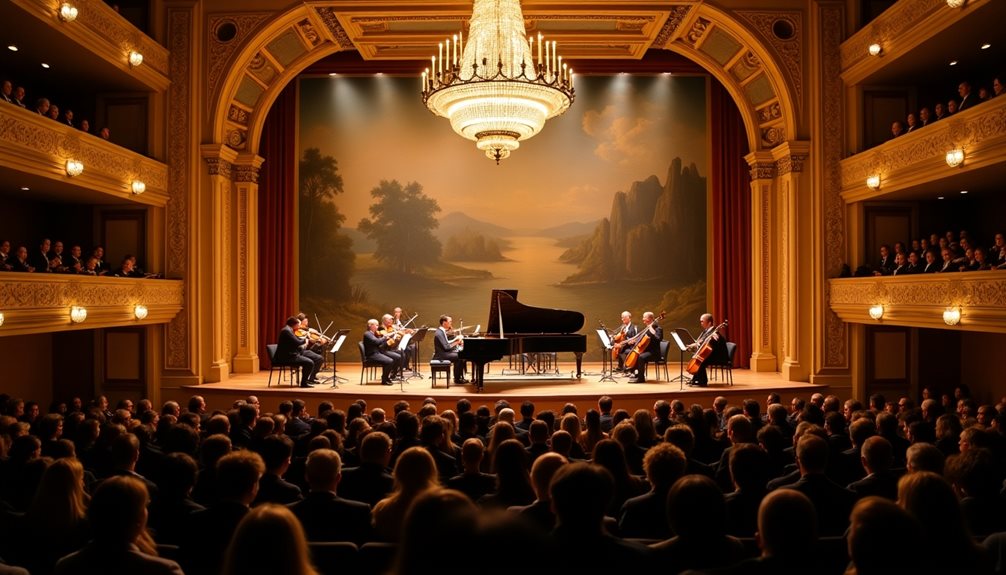
Russian composers found inspiration in their nation’s history and folklore, which led to a strong sense of romantic nationalism in classical music. Composers like Glinka and the Mighty Five played a key role in shaping this musical direction.
Glinka was among the first to blend Russian national identity with musical expression. He used folk elements to create pieces that evoked romantic themes, setting a path for future composers.
Building on Glinka’s foundation, the Mighty Five—Balakirev, Cui, Mussorgsky, Rimsky-Korsakov, and Borodin—developed this concept further. Through symphonic poems and operas, they captured the essence of the Russian soul. Their compositions showcased national pride with creative harmonies and detailed arrangements. They combined Russian musical styles with the emotional intensity of the broader Romantic movement.


